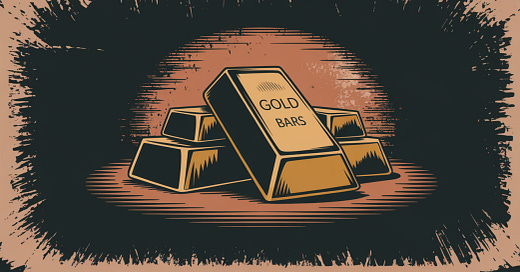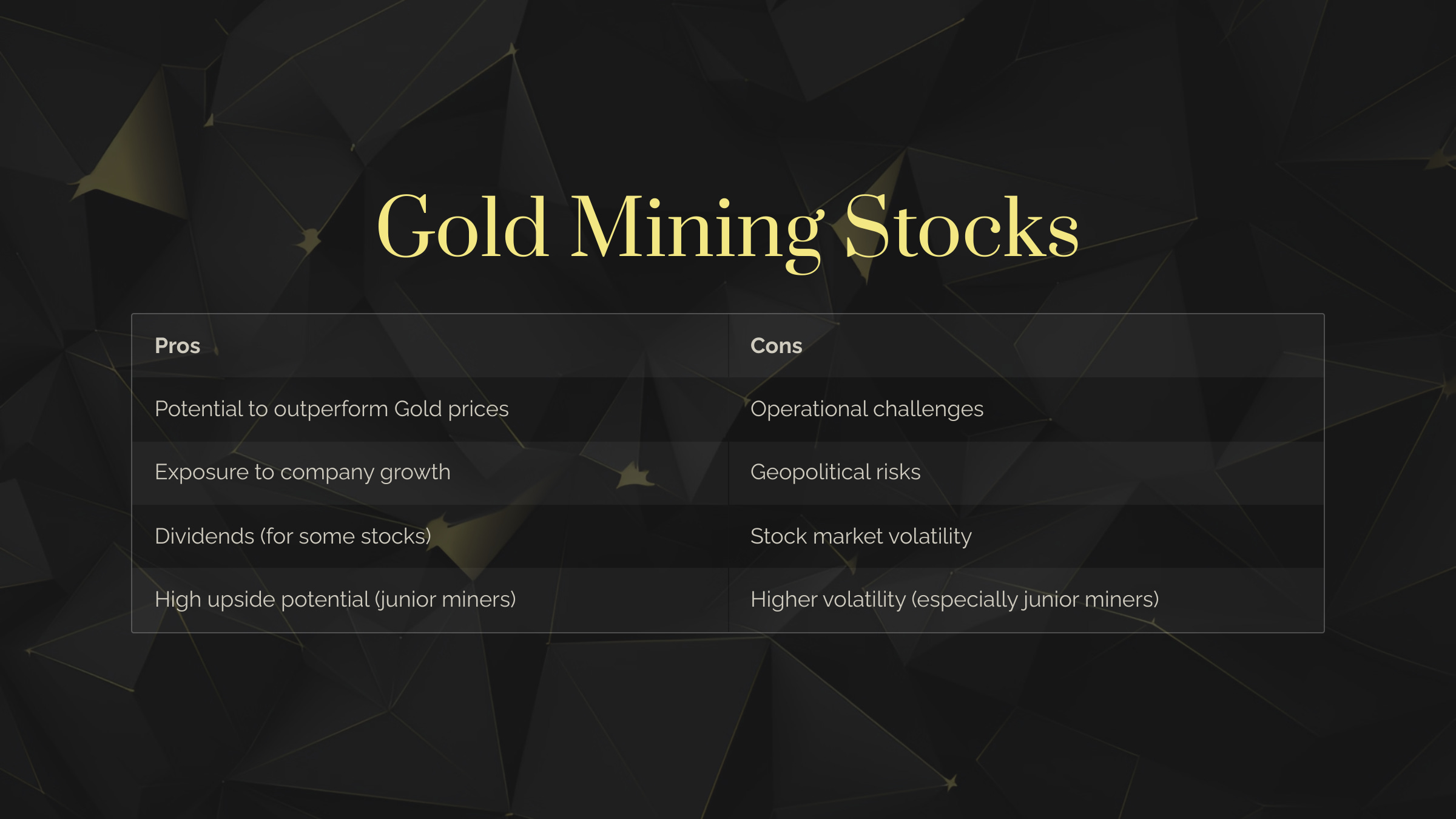Here's what I do with my XAU/USD profits: 4 solid ideas to turn trading gains into lasting wealth + example Gold portfolio
You’ve locked in some solid profits from trading XAU/USD. Now comes the big question:
What’s the best way to grow those gains without letting inflation eat into your hard-earned money?
While holding cash might seem safe, it’s not doing much to protect you from rising costs.
Instead, channeling a portion of your Gold profits into smart, Gold-based investments could help you grow your wealth over time—without being glued to your charts 24/7.
Today, let’s dive into four different ways to invest in Gold, each with its own unique benefits and risks.
After trading Gold for over a decade and testing nearly every strategy out there, I’m sharing what I’ve learned. Hopefully, this will give you some fresh ideas for making your Gold profits work even harder.
#1. Physical bullion
When you think about investing in Gold, the first image that probably pops into your mind is physical Gold—the real deal, the actual metal itself.
But why would a seasoned trader choose physical bullion when there are easier, more accessible paper options?
Two words: diversification and long-term security.
Types of physical Gold:
Gold Coins: Coins like the American Eagle, Canadian Maple Leaf, or South African Krugerrand are widely trusted, highly liquid, and easy to store. Produced by national mints, these coins typically offer 99.9% purity and come in smaller denominations, making them an ideal choice if you’re looking for flexibility.
Gold Bars: From 1 gram to hefty 400-ounce bars, Gold bars offer a more cost-effective way to invest in bulk. The premiums over spot price tend to be lower than coins, which is appealing to larger investors looking to minimize extra costs.
Now, let’s talk numbers.
At today’s spot price of around $2,600 per ounce, a standard 1-ounce Gold coin might carry a premium of 5%-10% above the spot price.
At today’s spot price of around $2,600 per ounce, a standard 1-ounce gold coin could come with a premium of 5%-10%, meaning you’d be paying closer to $2,800 per coin. These premiums can rise when demand spikes, but in return, you get a tangible asset that’s immune to broker risk and stock market volatility.
🟢 Pros:
Tangible wealth: It’s real, and it's in your hands.
No counterparty risk: There’s no risk that a company or government will default on you.
Hedge against inflation: A historic store of value, immune to currency devaluation.
🔴 Cons:
Storage issues: A high net worth in Gold can become a logistical headache.
Liquidity and premiums: Selling physical Gold usually incurs premiums, and you might face delays when liquidating.
#2. Gold ETFs and funds
If you’re a short- to mid-term trader, dealing with physical Gold might seem like a hassle. That’s where Gold ETFs (Exchange-Traded Funds) come in—offering Gold exposure without the headache of storage.
The 3 types of Gold ETFs:
Physical Gold ETFs: These are backed by actual Gold stored in vaults. A popular example is the SPDR Gold Shares ETF (GLD), which mirrors the price of physical Gold by holding bullion in trust. When you buy shares of GLD, you’re essentially owning a fraction of that stored Gold. The upside? No need to worry about storing it. The downside? You don’t actually get to hold the Gold in your hands.
Gold Futures ETFs: ETFs like ProShares Ultra Gold (UGL) or VelocityShares 3x Long Gold ETN (UGLD) track Gold through futures contracts. These ETFs are leveraged, which means they can offer bigger gains if Gold prices rise—but they can also magnify losses if the market moves against you. Leverage cuts both ways.
Gold Mining ETFs: Funds like GDX or GDXJ invest in Gold mining companies rather than the metal itself. This gives you exposure not just to the price of Gold but also to the success (or failure) of the companies extracting it. In a Gold bull market, mining stocks often outperform, but in tough times, they can lag behind.
🟢 Pros:
Liquidity: You can buy and sell ETFs like any other stock, making them far more liquid than physical gold.
Easy access: All you need is a brokerage account—no storage, shipping, or insurance concerns.
Diversification: You can build a portfolio with a mix of physical Gold, futures, and mining stocks, all through ETFs.
🔴 Cons:
Management fees: Over time, ETF fees can chip away at your returns.
Tax considerations: Many gold ETFs are taxed as collectibles, which means higher capital gains taxes—up to 28%.
#3. Gold mining stocks
If you’re looking to combine Gold exposure with the dynamics of the stock market, Gold mining stocks offer a unique way to tap into both.
Companies like Newmont Corporation (NEM) and Barrick Gold (GOLD) are major players in the industry. These firms extract, process, and sell Gold, giving investors a way to profit from both rising Gold prices and their operational performance.
However, mining stocks don’t always move in perfect sync with the price of Gold.
These companies face a range of risks—operational challenges, geopolitical uncertainties, and stock market fluctuations.
Even if Gold prices are climbing, a poorly managed mining company might struggle. On the other hand, a well-run miner can often outperform the price of Gold itself, especially during bull markets.
For those with a higher risk appetite, junior miners—smaller companies focused on exploration—can be particularly exciting. These firms are more volatile but offer greater upside when Gold prices surge.
Funds like GDXJ give you access to a diversified portfolio of junior miners, spreading the risk while still capturing potential gains.
🟢 Pros:
Higher upside potential: Mining stocks can generate returns that far outpace the price of Gold during bullish periods.
Dividends: Many larger mining companies pay dividends, providing a steady cash flow in addition to capital appreciation.
🔴 Cons:
Operational risks: Mines are exposed to delays, regulatory challenges, or environmental issues, which can hurt performance.
Stock market correlation: Mining stocks can be influenced by overall stock market movements, even if Gold prices are rising.
#4. Gold futures and options
When trading Gold futures, you’re entering a contract to buy or sell Gold at a specific price on a future date. The leverage involved means even small price movements can lead to significant gains—or losses.
Futures are ideal for traders looking to hedge or capitalize on short-term price movements.
Options on futures give you the right, but not the obligation, to buy or sell Gold at a set price before a specific date. This adds a powerful risk management tool to your arsenal, but it requires a solid grasp of options trading strategies.
🟢 Pros:
Leverage: You can control a large amount of Gold with a relatively small amount of capital, amplifying potential gains.
Hedging: Futures are often used to protect against short-term price swings, making them a popular choice for Gold traders managing risk.
🔴 Cons:
High leverage risk: Leverage cuts both ways—while it can boost profits, it can also lead to substantial losses if trades go against you.
Complexity: Futures and options trading requires a much deeper understanding of the markets, making them more complex than simply buying gold stocks or ETFs.
Example Gold investment portfolio
Your Gold investment strategy should strike a balance between safety and growth potential. For example, combining long-term physical bullion and short-term futures helps hedge against both inflation and market fluctuations. While, mining stocks and futures add higher return opportunities.
Let’s say we start with $100,000 profit. For beginners, this would be a smart and safe way to reinvest your profits.
Physical Gold (25%):
Allocation: $25,000
Type: 1-ounce coins (like American Eagles or Canadian Maple Leafs) and smaller bars (10-ounce bars)
Why: Provides long-term security and serves as a hedge. It’s a tangible, no-counterparty risk investment immune to stock market.
Gold ETFs (30%):
Allocation: $30,000
Type: Split between:
SPDR Gold Shares (GLD) (20%): Exposure to the physical Gold without the hassle of storage.
VanEck Gold Miners ETF (GDX) (10%): Exposure to large-cap Gold mining companies, providing both gold price exposure and the potential for dividends.
Why: Highly liquid, easier to manage than physical Gold, gives exposure to both the price of Gold and the operational success of Gold companies.
Gold Mining Stocks (20%):
Allocation: $20,000
Type: Major mining companies like Newmont Corporation (NEM) and Barrick Gold (GOLD), plus some exposure to junior miners via VanEck Junior Gold Miners ETF (GDXJ).
Why: Extra income via dividends and higher growth potential, especially during a bull market.
Gold Futures and Options (15%):
Allocation: $15,000
Type: Gold futures or options on futures for short-term trading, or leveraged ETFs like ProShares Ultra Gold (UGL).
Why: High risk, high reward with significant profit potential.
Cash Reserve (10%):
Allocation: $10,000
Type: Kept as cash or in low-risk, interest-bearing accounts.
Why: A safety net to manage market volatility as well as a chance buy more Gold at lower prices.
As always, diversification is key to long-term success. This creates a resilient portfolio that can not only withstand market fluctuations but also capitalize on new opportunities.
Safe trading,
and remember: All that glitters is not Gold,
Joe








